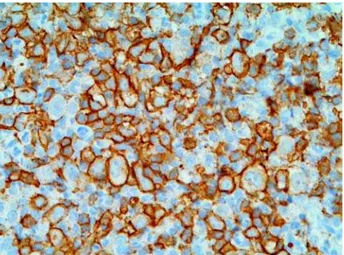64
Large B-Cell Lymphoma of the Prostate Case Report
International Braz J Urol Vol. 32 (1): 64-65, January - February, 2006
Primary Diffuse Large B-Cell Lymphoma of the Prostate in a
Young Patient
Carlos A. Alvarez, Begona I. Rodriguez, Luis A. Perez
Department of Pathology (CAA, BIR) and Department of Urology (LAP), Hospital POVISA, Vigo,
Spain
ABSTRACT
We report a primary lymphoma of the prostate, which arose in a 29-year-old man with hematuria. Pathological evaluation of tissue fragments allowed us to choose appropriate medical management. A diagnosis of suspicion can be performed by urine cytology, and molecular techniques may be helpful. Emphasis in differential diagnosis is made.
Key words: prostatic neoplasms; diagnosis; lymphoma, non-Hodgkin; chemotherapy Int Braz J Urol. 2006; 32: 64-5
INTRODUCTION
Primary lymphomas of the prostate are a rare but well-recognized entity. They account for 0.09% of prostate neoplasms and 0.1% of all non-Hodgkin lymphomas (1). The symptoms at presentation are similar to other prostatic diseases (2), and histopatho-logical analysis with immunohistochemical tech-niques and molecular studies are mandatory to reach final diagnosis. Although rare, this entity should be kept in mind to avoid unnecessary surgery.
CASE REPORT
A 29-year-old male presented a 3-month his-tory of mild hematuria. Urine cytology revealed atypi-cal cells of uncertain histogenesis. Several submu-cosal nodules were seen on cystoscopy involving the prostatic urethra, and a biopsy was performed. Mi-croscopically, an ulcerated neoplasm made up of large discohesive cells infiltrating prostatic tissue was ob-served. The cells had abundant amphophilic
cyto-plasm, pleomorphic nuclei and prominent nucleoli (Figure-1). Mitoses were frequent and often atypi-cal. Malignant cells expressed immunoreactivity for CD20 (Figure-2) and CD30 (focally), and were nega-tive for CD3, CD10, CD15, LMP-1, p53, bcl2 and bcl6. Polymerase chain reaction analyses demon-strated monoclonal immunoglobulin heavy-chain gene rearrangement. Bone marrow biopsy, complete blood count, serum prostate-specific antigen (PSA) and computerized tomography of the thorax, abdo-men, and pelvis were normal. Gallium scan revealed a focus of isotope retention in the prostate. A final diagnosis of primary diffuse large B-cell lymphoma (DLBCL) of the prostate was rendered.
He was administered 6 cycles of chemo-therapy CHOP (cyclophosphamide, doxorubicin, vin-cristine, and prednisone), and rituximab. The patient is disease-free after 9 months follow-up.
CONCLUSIONS
lym-65
Large B-Cell Lymphoma of the Prostate
phoid nodules or extramedullary hematopoiesis, or it is an spread from the involvement in disseminated disease (1,2). Criteria to classify a lymphoma as pri-mary include urinary symptoms at presentation and pros-tate confined tumor, without involvement of the hemato-poietic system within 1 month of diagnosis (2).
All types of lymphoma have been described, with DLBCL being most common (2). The age of patients ranges from 5 to 89 years (mean, 62 years) (1,2). The most frequent symptoms at presentation are those related to prostate enlargement, including urinary urgency and frequency (1,2). Tumor in our case was identified at early stage, and the patient pre-sented hematuria due to neoplasm ulceration. Serum PSA was normal (2).
Primary prostate lymphoma can be confidently diagnosed by histopathology, employing ancillary stud-ies, such as immunophenotypic and molecular tech-niques. In the correct setting, a diagnosis of suspicion can be made by urine cytology. Differential diagnosis includes prostatitis, small cell carcinoma, lymphoepi-thelioma-like carcinoma and Hodgkin lymphoma (HL). The distinction between lymphoma and other malig-nant tumors can be readily accomplished immunohistochemically, and inflammatory conditions can be ruled out according to morphological criteria. Negativity for CD15 and LMP-1 helps to exclude HL. Several therapeutic modalities have been re-ported, including prostatectomy, radiotherapy, and che-Figure 1 – Photomicrograph showing that the tumor consists of a predominant population of centroblasts and immunoblasts admixed with inflammatory mature cells (HE, X100).
Figure 2 – Intense positive immunostaining with the B cell marker CD20 (X250).
motherapy (2). Radical surgery is not indicated since local disease is well controlled with chemotherapy or radiation therapy (3). Although the prognosis of these tumors was classically considered poor (2), some ar-ticles suggest that prolonged survival could be expected with chemotherapy or radiotherapy (3). Our patient remained well 9 months after diagnosis.
REFERENCES
1. Ferry JA, Young RH: Malignant lymphoma of the geni-tourinary tract. Curr Diag Pathol. 1997; 4: 145-69 2. Bostwick DG, Iczkowski KA, Amin MB, Discigil G,
Osborne B: Malignant lymphoma involving the pros-tate: report of 62 cases. Cancer. 1998; 83: 732-8. 3. Mermershtain W, Benharroch D, Lavrenkov K, Geffen
DB, German I, Cohen Y: Primary malignant lymphoma of the prostate—a report of three cases. Leuk Lym-phoma. 2001; 42: 809-11.
Accepted after revision: August 15, 2005
Correspondence address:
Dr. Carlos Álvarez Álvarez Hospital Montecelo
Mourente-Montecelo, 36071 Pontevedra, Spain
Fax: + 00 34 980-0077
